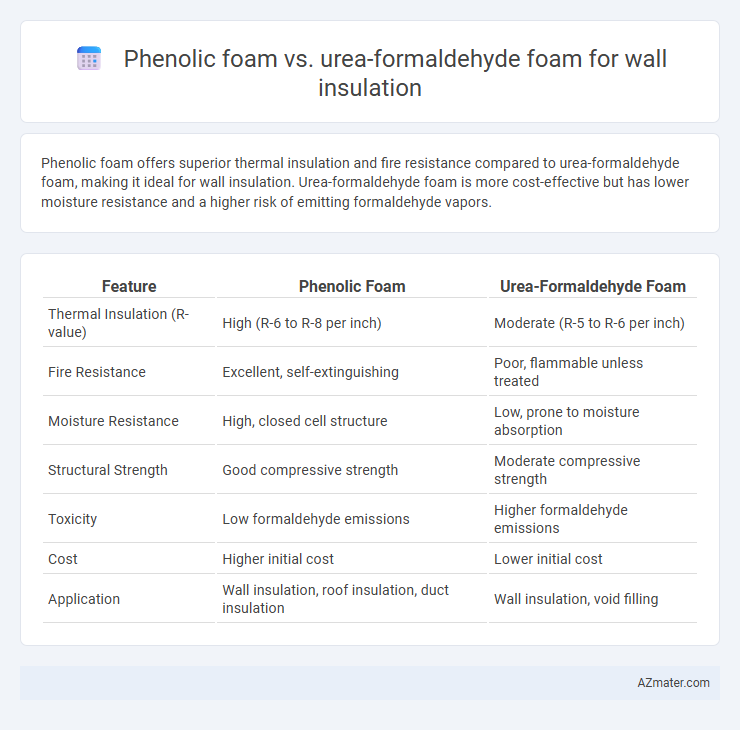Phenolic foam offers superior thermal insulation and fire resistance compared to urea-formaldehyde foam, making it ideal for wall insulation. Urea-formaldehyde foam is more cost-effective but has lower moisture resistance and a higher risk of emitting formaldehyde vapors.
Table of Comparison
| Feature | Phenolic Foam | Urea-Formaldehyde Foam |
|---|---|---|
| Thermal Insulation (R-value) | High (R-6 to R-8 per inch) | Moderate (R-5 to R-6 per inch) |
| Fire Resistance | Excellent, self-extinguishing | Poor, flammable unless treated |
| Moisture Resistance | High, closed cell structure | Low, prone to moisture absorption |
| Structural Strength | Good compressive strength | Moderate compressive strength |
| Toxicity | Low formaldehyde emissions | Higher formaldehyde emissions |
| Cost | Higher initial cost | Lower initial cost |
| Application | Wall insulation, roof insulation, duct insulation | Wall insulation, void filling |
Introduction to Wall Insulation Materials
Phenolic foam offers superior thermal insulation with a low thermal conductivity of around 0.020 W/m*K, making it highly effective for wall insulation in energy-efficient buildings. Urea-formaldehyde foam, while more economical, has higher thermal conductivity around 0.033 W/m*K and lower fire resistance compared to phenolic foam. Both materials provide lightweight, rigid insulation; however, phenolic foam's improved fire retardancy and moisture resistance make it preferable for high-performance wall insulation applications.
Overview of Phenolic Foam Insulation
Phenolic foam insulation is a high-performance, rigid foam known for its superior thermal resistance and low combustibility compared to urea-formaldehyde foam. Its closed-cell structure provides excellent moisture resistance and structural strength, making it ideal for wall insulation applications that demand energy efficiency and fire safety. Phenolic foam also offers a higher R-value per inch, ensuring better insulation performance within limited wall cavity thickness.
Overview of Urea-Formaldehyde Foam Insulation
Urea-formaldehyde foam insulation (UFFI) is a low-cost, lightweight material primarily used for cavity wall and attic insulation, known for its effective thermal resistance values ranging between R-4 to R-5 per inch. This closed-cell foam has moderate fire resistance and good soundproofing qualities but can release formaldehyde gas, raising indoor air quality concerns if improperly installed or aged. Compared to phenolic foam, UFFI offers lower moisture resistance and durability, making it less suitable for high-moisture environments or long-term applications.
Thermal Performance Comparison
Phenolic foam offers superior thermal performance with a lower thermal conductivity value, typically around 0.020 W/m*K, compared to urea-formaldehyde foam which ranges from 0.030 to 0.040 W/m*K. The closed-cell structure of phenolic foam provides enhanced insulation efficiency and better long-term thermal resistance, making it ideal for high-performance wall insulation. Urea-formaldehyde foam, while cost-effective, tends to absorb moisture more readily, leading to decreased insulation effectiveness over time.
Fire Resistance and Safety
Phenolic foam exhibits superior fire resistance compared to urea-formaldehyde foam, with a higher ignition temperature and slower flame spread, making it ideal for wall insulation in fire-prone areas. Phenolic foam releases fewer toxic gases and lower smoke density upon combustion, enhancing safety for building occupants during a fire event. Urea-formaldehyde foam tends to off-gas formaldehyde and is more combustible, posing higher health risks and less effective fire protection in insulated walls.
Moisture Resistance and Durability
Phenolic foam offers superior moisture resistance compared to urea-formaldehyde foam, making it highly effective in preventing water absorption and reducing the risk of mold growth in wall insulation. Its closed-cell structure enhances durability by maintaining thermal performance and structural integrity over time, even in humid environments. Urea-formaldehyde foam, while cost-effective, tends to absorb moisture more readily, leading to potential degradation and reduced insulation lifespan.
Environmental Impact and Sustainability
Phenolic foam offers superior environmental performance due to its low global warming potential (GWP) and excellent fire resistance, reducing long-term environmental risks compared to urea-formaldehyde foam. Urea-formaldehyde foam, while cost-effective, emits formaldehyde, a harmful volatile organic compound (VOC) that negatively impacts indoor air quality and contributes to environmental pollution. Sustainable building projects favor phenolic foam for its improved insulation efficiency, lower greenhouse gas emissions during production, and enhanced durability, aligning with green building certifications like LEED and BREEAM.
Installation Process and Practicality
Phenolic foam offers a lightweight and rigid structure that allows for quick and clean installation with minimal expansion, making it ideal for precision filling in wall cavities. Urea-formaldehyde foam requires careful mixing and can expand unpredictably, demanding skilled application to avoid gaps and ensure consistent insulation. Phenolic foam provides better fire resistance and moisture stability, enhancing overall practicality in long-term wall insulation projects.
Cost Analysis and Long-Term Value
Phenolic foam insulation typically costs more upfront compared to urea-formaldehyde foam but offers superior thermal performance and fire resistance, resulting in lower energy bills and reduced maintenance costs over time. Urea-formaldehyde foam is more affordable initially but may require more frequent repairs or replacement due to lower durability and potential off-gassing concerns. Evaluating long-term value, phenolic foam provides better return on investment through enhanced insulation efficiency and increased building safety standards compliance.
Conclusion: Choosing the Right Foam for Wall Insulation
Phenolic foam offers superior thermal insulation and fire resistance due to its closed-cell structure and high char yield, making it ideal for applications requiring enhanced safety and long-term energy efficiency. Urea-formaldehyde foam is cost-effective and easy to apply, but it has lower moisture resistance and emits formaldehyde gas over time, which may impact indoor air quality. Selecting the right foam depends on balancing budget constraints, insulation performance, and health considerations specific to the building environment.

Infographic: Phenolic foam vs Urea-formaldehyde foam for Wall insulation
 azmater.com
azmater.com